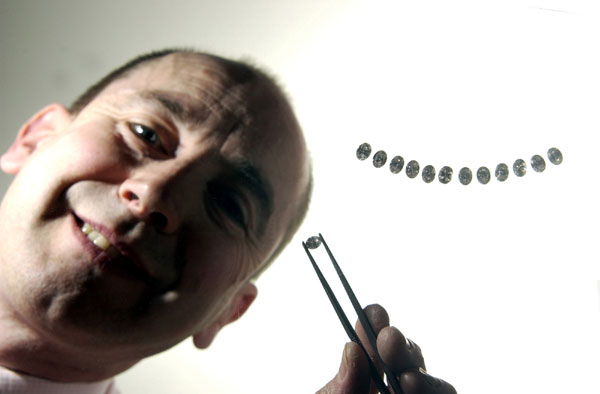Renowned jeweller and gems expert works with public relations to warn of rise in fakes that can fool some jewellers

ALISTIR Tait, the leading antique and fine jeweller, is warning Scots consumers to be on their guard against an influx of bogus diamonds which are so convincing they can fool High Street jewellers.
He believes a growing number of Scots are being conned into buying the manmade copies and is urging those travelling abroad to ignore apparent diamond bargains.
In the past month he has seen three customers in his shop, Alistir Wood Tait in Rose Street, Edinburgh, asking to have sizeable diamonds valued. In each case the stones were fakes.
Alistir, a respected Fellow of the Gemmological Association and member of the National Association of Goldsmiths, said: “People are convinced they are buying real diamonds.
Manmade diamonds that can fool jewellers
 “In fact the stones are moissanite, an extremely realistic manmade alternative which is produced in a laboratory. they are so close to real diamonds they will actually pass the two basic tests which most jewellery shop staff use to test stones.”
“In fact the stones are moissanite, an extremely realistic manmade alternative which is produced in a laboratory. they are so close to real diamonds they will actually pass the two basic tests which most jewellery shop staff use to test stones.”
Inferior diamond-like gems, including cubic zirconium can easily be weeded out using simple tests with fluorescent light or a small electrical current. However moissanite passes each of these tests, which means even staff in jewellery shops can be fooled.
Alistir added: “Most jewellers are not gemmologists and the only definitive way to tell diamonds from moissanite is to run more detailed, specialised tests.
“Moissanite has only been produced on a commercial basis for a few short years and is becoming quite popular in America as an affordable alternative to diamonds.
Discovered in a meteor crater
“That means moissanite is relatively simple to get a hold of and it is clear unscrupulous people are doing just that to pass it off as the genuine article.
“The victims we have encountered either bought their stones in America or Turkey. They come to us hoping to confirm they had landed the bargain of a lifetime. Unfortunately we had to break them the bad news, which left them pretty crestfallen.”
Moissanite was first identified in 1893 by Nobel Prize-winning French scientist, Dr Henri Moissan, studying samples taken from a huge meteor crater in Arizona. Its qualities of light dispersion and brilliance actually exceed those of diamonds.
However, it could not be manufactured successfully in the lab for almost 100 years. In 1995 a master diamond cutter suggested to the founders of US jewellers Charles & Colvard that, if properly cut, the crystals could make a beautiful jewel.
From the West Wing to CSI: Crime Scene Investigation
 Charles & Colvard helped set up a lab to develop larger gemstones and is now the exclusive worldwide manufacturer and marketer of the lab-created stones, which have appeared in TV shows like Sex and the City and the West Wing. It also featured in an episode of CSI: Crime Scene Investigation, where forensic experts were shown carrying out detailed tests on moissanite samples.
Charles & Colvard helped set up a lab to develop larger gemstones and is now the exclusive worldwide manufacturer and marketer of the lab-created stones, which have appeared in TV shows like Sex and the City and the West Wing. It also featured in an episode of CSI: Crime Scene Investigation, where forensic experts were shown carrying out detailed tests on moissanite samples.
Despite selling at a tenth of the cost of diamonds, moissanite stones are expensive compared with other manmade gemstones and Mr Tait added: “There is now a slowly emerging market in the UK for these stones, which admittedly are beautiful in their own right.
“If someone wants to buy ready-made moissanite jewellery, they know exactly what they are getting. But they are not diamonds and despite their looks these stones still lack that special something.
“Anyone tricked into thinking they are diamonds will be left with nothing except a pretty stone and no chance of getting their money back. More stones will come out of America before people in Britain are aware of this, so the problem is bound to get worse before it gets better.”
The jeweller has also seen tourists duped into buying worthless manmade gemstones at remote markets in Vietnam and others who believed they were buying rubies from peasants panning rivers in Sri Lanka.
He added: “In fact the stones were manmade and had been altered to look as though they came direct from the riverbed. Travellers find it hard to believe they could be tricked by simple peasants in extremely remote areas. The fact is the peasants know more about gemstones than they do.”
Alistir has helped the jewellery trade in Scotland successfully campaign against “Blood Diamonds” from countries with brutal or repressive regimes. He is also currently helping the Scottish Executive to devise a strategy to allow the sale of antique Scottish Pearls while upholding a ban which prevents exploitation of the rare freshwater mussels they come from.
Last year he landed a large collection of rare Scottish gold, sold to him by a prospector who had panned every river in Scotland, but had decided to sell up and pursue a new hobby.
Find out how our public relations experts can help your business stand out from the competition
Getting in touch with us couldn’t be easier. Phone us on 0131 561 2244, or take a few seconds to fill and submit the simple form below and we’ll get straight back to you:
Contact Form











